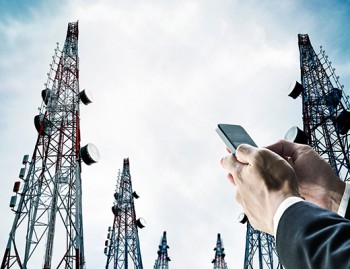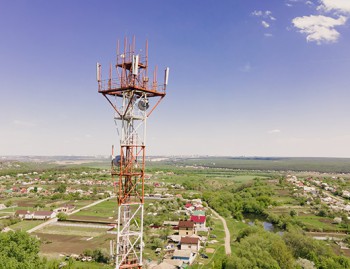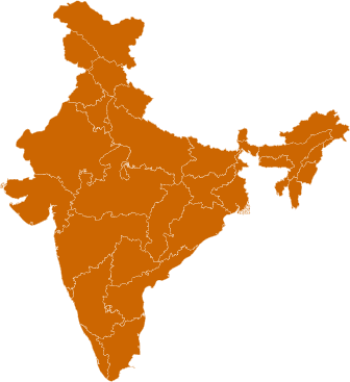INTRODUCTION
Currently, India is the world’s second-largest telecommunications market with a subscriber base of 1.16 billion and has registered strong growth in the last decade. The Indian mobile economy is growing rapidly and will contribute substantially to India’s Gross Domestic Product (GDP) according to a report prepared by GSM Association (GSMA) in collaboration with Boston Consulting Group (BCG). In 2019, India surpassed the US to become the second largest market in terms of number of app downloads.
The liberal and reformist policies of the Government of India have been instrumental along with strong consumer demand in the rapid growth in the Indian telecom sector. The Government has enabled easy market access to telecom equipment and a fair and proactive regulatory framework, that has ensured availability of telecom services to consumer at affordable prices. The deregulation of Foreign Direct Investment (FDI) norms have made the sector one of the fastest growing and the top five employment opportunity generator in the country.

MARKET SIZE

India is the world’s second-largest telecommunications market. The total subscriber base, wireless subscriptions as well as wired broadband subscriptions have grown consistently. Tele-density stood at 85.91%, as of December 2021, total broadband subscriptions grew to 792.1 million until December 2021 and total subscriber base stood at 1.18 billion in December 2021.
Gross revenue of the telecom sector stood at Rs. 64,801 crore (US$ 8.74 billion) in the first quarter of FY22.
The total wireless data usage in India grew 16.54% quarterly to reach 32,397 PB in the first quarter of FY22. The contribution of 3G and 4G data usage to the total volume of wireless data usage was 1.78% and 97.74%, respectively, in the third quarter of FY21. Share of 2G data usage stood at 0.48% in the same quarter.
Over the next five years, rise in mobile-phone penetration and decline in data costs will add 500 million new internet users in India, creating opportunities for new businesses.
By 2025, India will need ~22 million skilled workers in 5G-centric technologies such as Internet of Things (IoT), Artificial Intelligence (AI), robotics and cloud computing.
INVESTMENT/MAJOR DEVELOPMENT
With daily increasing subscriber base, there have been a lot of investment and development in the sector. FDI inflow in the telecom sector stood at US$ 38.25 billion between April 2000-December 2021.
Some of the developments in the recent past are:
- In January 2022, Google made a US$ 1 billion investment in Airtel through the India Digitization Fund.
- In October 2021, Vodafone Idea stated that it is in advanced talks to sell a minority stake to global private equity investors including Apollo Global Management and Carlyle to raise up to Rs. 7,540 crore (US$ 1 billion) over the next 2-3 months.
- In October 2021, British satellite operator Inmarsat Holdings Ltd. announced that it is the first foreign operator to get India’s approval to sell high-speed broadband to planes and shipping vessels. Inmarsat will access the market via Bharat Sanchar Nigam Ltd. (BSNL) after BSNL received a license from the Department of Telecommunications.
- In October 2021, Dixon Technologies announced plans to invest Rs. 200 crore (US$ 26.69 million) under the telecom PLI scheme; this investment will include the acquisition cost of Bharti Group’s manufacturing unit.
- In September 2021, Bharti Airtel announced an investment of Rs. 50 billion (US$ 673 million) in expanding its data centre business to meet the customer demand in and around India.
- In August 2021, Tata Group company Nelco announced that the company is in talks with Canadian firm Telesat to sign a commercial pact for launching fast satellite broadband services in India under the latter’s Lightspeed brand, a move which will pit the combined entity against Bharti Enterprises-backed OneWeb, Elon Musk’s SpaceX and Amazon.
- In March 2021, Vodafone Idea Ltd. (VIL) announced that the acquired spectrum in five circles would help improve 4G coverage and bandwidth, allowing it to offer ‘superior digital experience’ to customers.
- In March 2021, Advanced Television Systems Committee (ATSC) and Telecommunications Standards Development Society, India (TSDSI) signed a deal to boost adoption of ATSC standards in India in order to make broadcast services available on mobile devices. This allows the TSDSI to follow ATSC standards, fostering global digital broadcasting standard harmonisation.
- In the first quarter of FY21, customer spending on telecom services increased 16.6% y-o-y, with over three-fourths spent on data services. This spike in consumer spending came despite of the COVID-19 disruption and lack of access of offline recharges for a few weeks
- India had over 500 million active internet users (accessed Internet in the last one month) as of May 2020.
GOVERNMENT INITIATIVES
The Government has fast-tracked reforms in the telecom sector and continues to be proactive in providing room for growth for telecom companies. Some of the key initiatives taken by the Government are as follows:
- In Union Budget 2022-23 the Department of Telecommunications was allocated Rs. 84,587 crore (US$ 11.11 billion) out of which Rs. 30,436 crore (US$ 3.99 billion) was revenue expenditure which was 36% of the total expenditure and Rs. 54,150 crore (US$ 7.11 billion) was capital expenditure which is 64.01% of total expenditure.
- To drive the development of 6G technology, the Department of Telecommunications (DoT) has developed a sixth generation (6G) innovation group.
- In October 2021, Telecom Secretary Mr. K. Rajaraman inaugurated the Quantum Communication Lab at the Centre for Development of Telematics (C-DOT), Delhi, and unveiled the indigenously developed Quantum Key Distribution (QKD) solution by C-DOT. QKD can support a distance of >100 kms on standard optical fibre.
- In August 2021, the Department of Telecommunications (DoT) initiated discussions with banks to address financial stress in the telecom sector, particularly Vodafone Idea Ltd. (VIL) that urgently requires fund infusion to stay afloat.
- In August 2021, the Department of Telecommunications (DoT) officials stated that it is working on a package, which includes reducing the revenue share licence fee to 6% of adjusted gross revenue (AGR) of the operators from the current 8%. This would be done by reducing the 5% universal service obligation levy by two percentage points and provid
- In July 2021, Bharat Broadband Network Limited (BBNL), on behalf of the Department of Telecommunication, invited global tender for the development of BharatNet through the Public-private Partnership model in 9 separate packages across 16 states for a concession period of 30 years. Under this project, the government will provide a maximum grant
- The Rs. 12,195 crore (US$ 1.65 billion) production-linked incentive (PLI) scheme or telecome is expected to bring in investment of around Rs. 3,000 crore (US$ 400.08 million) and generate huge direct and indirect employment.
- In April 2021, the government pointed out that firms such as Ericsson and Nokia are now eager to expand their operations in India, and global companies like Samsung, Cisco, Ciena and Foxconn have expressed interest to set up their manufacturing base in the country for telecom and networking products.
- In March 2021, TEPC (Telecom Equipment Export Promotion Council) organised India Telecom 2021—a platform for convergence of technologies and business exchange.
- The Union Cabinet approved Rs. 12,195 crore (US$ 1.65 billion) production-linked incentive (PLI) scheme for telecom & networking products under the Department of Telecom.
- In 2021-22, the Department of Telecommunications has been allocated Rs. 58,737.00 crore (US$ 8 billion). 56% allocation is towards revenue expenditure and the remaining 44% is towards capital expenditure.
- Under Union Budget 2021-22, the government allocated Rs. 14,200 crore (US$ 1.9 billion) for telecom infrastructure that entails completion of optical fibre cable-based network for Defence services, rolling out broadband in 2.2 lakh panchayats and improving mobile services in the North East.
- On January 15, 2021, India and Japan signed an MoU to enhance cooperation in the field of Information and Communications Technologies. The MoU was signed between the Union Minister for Communications, Electronics and IT, Ravi Shankar Prasad, and the Japanese Minister for Internal Affairs and Communications, Takeda Ryota.
- On January 6, 2021, the Department of Telecommunications (DoT) issued Notice Inviting Applications (NIA) for auction of Spectrum in 700 MHz, 800 MHz, 900 MHz, 1,800 MHz, 2,100 MHz, 2,300 MHz and 2,500 MHz bands. Last date for submission of applications for participation in the auction is February 5, 2021, and auction to commence online from Mar
- In December 2020, the Union Cabinet, chaired by the Prime Minister, Mr. Narendra Modi, approved a proposal by Department of Telecommunications for setting up of Public Wi-Fi Networks by Public Data Office Aggregators (PDOAs) to provide public Wi-Fi services through Public Data Offices (PDOs).
- In December 2020, the Union Cabinet, chaired by the Prime Minister, Mr. Narendra Modi, approved the provision of submarine optical fibre cable connectivity between Mainland (Kochi) and Lakshadweep Islands (KLI Project).
- On November 4, 2020, The Union Cabinet, chaired by the Prime Minister, Mr. Narendra Modi, approved to sign a Memorandum of Understanding (MoU) between the Ministry of Communication and Information Technology and the Department of Digital, Culture, Media and Sports (DCMS) of United Kingdom Government on cooperation in the field of telecommunicat
- On September 21, 2020, Prime Minister, Mr. Narendra Modi launched a project to connect all 45,945 villages in Bihar with optical fibre internet service. This project will be completed by March 31, 2021 at a cost of Rs. ~1,000 crore (US$ 135.97 million); Rs. 640 crore (US$ 87.01 million) of capital expenditure will be funded by Department of Tel
- In March 2020, the government approved the Production Incentive Scheme (PLI) for Large- scale Electronics Manufacturing. The scheme proposes production-linked incentive to boost domestic manufacturing and attract large investments in mobile phone manufacturing and specified electronic components including Assembly, Testing, Marking and Packagin
- FDI cap in the telecom sector has been increased to 100% from 74%; out of 100%. In October 2021, the government notified 100% foreign direct investment (FDI) via the automatic route from previous 49% in the telecommunications sector. FDI of up to 100% is permitted for infrastructure providers offering dark fibre, electronic mail and voice mail.
ACHIEVEMENTS
Following are the achievements of the Government in the past four years:
- Department of Telecommunication launched ‘Tarang Sanchar’ - a web portal sharing information on mobile towers and EMF Emission Compliances.
- Payments on unified payments interface (UPI) hit an all-time high of 3.65 billion (by volume), with transactions worth ~Rs. 6.54 trillion (US$ 87.11 billion) in September 2021.
- Over 75% increase in internet coveragefrom 251 million users to 446 million.
ROAD AHEAD
Revenue from the telecom equipment sector is expected to grow to US$ 26.38 billion by 2020. The number of internet subscribers in the country is expected to double by 2021 to 829 million and overall IP traffic is expected to grow four-fold at a CAGR of 30% by 2021.
According to a Zenith Media survey, India is expected to become the fastest-growing telecom advertisement market, with an annual growth rate of 11% between 2020 and 2023.
The Indian Government is planning to develop 100 smart city projects, and IoT will play a vital role in developing these cities. The National Digital Communications Policy 2018 envisaged attracting investment worth US$ 100 billion in the telecommunications sector by 2022. App downloads in India is expected to increase to 18.11 billion in 2018F and 37.21 billion in 2022F.

Note: Conversion rate used in October 2021, Rs 1 = US$ 0.01324
References: Media Reports and Press Releases, Cellular Operators Authority of India (COAI), Telecom Regulatory Authority of India (TRAI), Department of Telecommunication (DoT), Department for Promotion of Industry and Internal Trade (DPIIT), India Services Sector Report by Deloitte
Note: IP - Internet Protocol, PB - Petabytes
Disclaimer: This information has been collected through secondary research and IBEF is not responsible for any errors in the same.
Telecommunication India
- Mahanagar Telephone Nigam Ltd. (MTNL)
- Bharat Sanchar Nigam Ltd. (BSNL)
- Bharti Airtel
- Vodafone Idea Limited
- Reliance Jio Infocomm

Industry Contacts
- Department of Telecommunication
- Association Of Competitive Telecom Operators (ACTO)
- Internet & Mobile Association Of India (IAMAI)